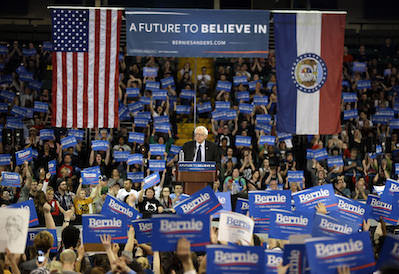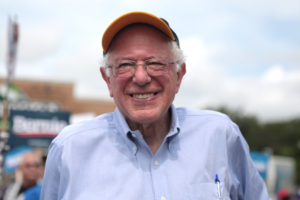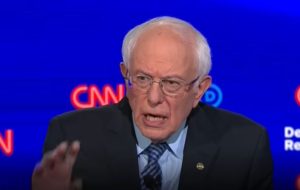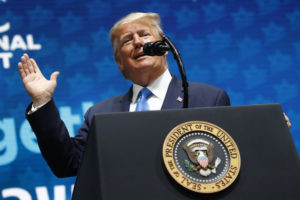Bernie Sanders’ Political Revolution Still Can Triumph and Transform America. Here’s How.
The senator's quest for the Democratic nomination appears lost after Tuesday’s elections. But if left progressives implement his ideals locally, the spirit he has inspired can find a lasting place in the nation's political life. Bernie Sanders has raised more than $60 million in 2016 and inspired a grass-roots political revolution in the United States. (Jeff Roberson / AP)
Bernie Sanders has raised more than $60 million in 2016 and inspired a grass-roots political revolution in the United States. (Jeff Roberson / AP)
By Alan Minsky
The Bernie Sanders campaign has shown that traditional left-wing politics are far more popular among the American public than anyone realized a few months ago. Indeed, Sanders’ surprising success suggests that American left progressives are the most underrepresented constituency in the country. And given that Sanders’ campaign was probably the first time millions of Americans encountered these ideas, it’s reasonable to think they will become even more popular with greater familiarity.
Thus, the 2016 Sanders campaign for president, however the second half of the primary process plays out, should be a starting point, not the end game. But given the sorry history of left politics in America, there’s every reason to think nothing will come of it. So the salient questions for left progressives are:
What would it take for this time to be different? Can the Sanders campaign be the spark that creates lasting and powerful left progressive politics in the United States?
I don’t think there’s a choice. It has to be. The problems facing the country and the world are too serious and seemingly intractable (the destruction of a middle-class society, mass incarceration, institutionalized racism, permanent warfare, environmental collapse, etc.). Not only does the political establishment have no remedy, it has been instrumental in the creation of these problems. Millions upon millions of Americans recognize this, including a majority of young people. Leaving them hopeless is not acceptable, especially after Sanders proposed a compelling alternative. We must pursue a strategy to maintain the momentum of the senator’s campaign and win political power.
In November 2014, just after the Democrats suffered a crushing defeat in the midterm elections, I wrote an article for Truthdig, “This Democratic Party Is Going Nowhere. Can Progressives Take It Over and Change the World?” in which I proposed that a left progressive candidate, either Elizabeth Warren or more likely Bernie Sanders, run for president in order to introduce the nation to a left progressive platform and set the table for running like-minded candidates in every one of the 435 districts of the United States Congress and for every elected position in the country. At the time, I anticipated that Sanders could do much better than anyone else seemed to think possible, but even I didn’t anticipate the level of success he ultimately has achieved. Sanders’ success has confirmed the central thesis of my article: that a coherent left progressive platform would be very popular with rank-and-file Democrats and even a broad array of voters outside the party. Such a platform directly and rationally addresses the central issues we face as a society.
However, unlike in the scenario outlined in my article, progressive Democrats did not organize a unified national slate of 435 congressional candidates for the 2016 election. Outside of a few other stray races, the Sanders insurgency has been the sole focus of American left progressives active in the electoral realm, which means a newly revived left progressive politics is poised once again to do an all-too-familiar disappearing act. Not surprisingly given my 2014 article, I believe that what has to happen now, before the Sanders campaign folds up its tent and goes home, is that the campaign has to pivot and start organizing a movement committed to running left progressives in every significant election in the country. In contrast to late 2014, in early 2016 we know for sure that there are legions of Americans ready and willing to participate in such a movement — and the candidates themselves can be drawn from Sanders’ campaign activists, and other left activists, from every locale across the land.
How can it get done? As no doubt everyone reading this knows, Sanders has stated that his campaign was conceived as more than just an effort to elect one man. It was and is a political revolution, calling for a revitalization of American democracy in which the people will take back the country for themselves from the oligarchs who have been firmly in control in recent times. However, at no time has the candidate, or his campaign, signaled a desire to organize a slate of left progressive candidates in the manner I outlined in 2014. So let me state clearly that I see no other path forward for the Sanders revolution.
Sanders has implied that, if elected, he would confront challenges from members of Congress who did not support his agenda. He did this at a town hall meeting on March 7 when he said members of Congress who stood in the way would soon “learn firsthand what it’s like to be unemployed.” However, in an earlier exchange, with MSNBC’s Chris Matthews, Sanders expressed confidence that masses of people “outside the windows” of Congress mobilized in support of his agenda would sway reluctant Congress members to give him the votes he needed. Sanders was far from convincing on this occasion, and I do not believe that current elected officials who have organized their entire adult life to be on the congressional gravy train would give in to such public pressure. In contrast, I think both Republicans and conservative Democrats would feel confident that, with the full backing of the mainstream media, they could wait out the storm. A much more realistic scenario for a President Sanders to pass his ambitious legislative program would be to do like Santa: see who in Congress is being naughty or nice, keep the public up to speed on the obstruction of the programs they voted for, and then, in marked contrast to Barack Obama in 2010, bring a left progressive challenge in every congressional district and Senate seat on the ballot in 2018, both in the primaries and in the general election. The goal would be a legislative revolution in January 2019 (with a nice byproduct of a fully engaged citizenry at his back).
Of course, our current scenario is quite different. It seems unlikely at the moment that we’ll have a President Sanders, but that doesn’t negate the idea that the best way to maintain the momentum generated by the Sanders campaign is to organize a left progressive electoral slate across the country. How else can left progressives reverse damaging public policies and implement positive programs designed to protect the environment, combat poverty, grow the middle class, reform the criminal justice system and so on? And, of course, the left progressive candidates at the state and local level will be able to cross-fertilize with social justice movements and respond to the needs of people at a daily, local level — to a much greater degree than a national presidential race ever could.Is it realistic to think that the Sanders campaign and its supporters can make this pivot to focus on the future? That, of course, is ultimately up to the Vermont senator, his campaign staff and his millions of (truly fervent) supporters. (Paradoxically, I am certain this would be the best possible move to revitalize Sanders’ presidential aspirations and produce the landslide victories necessary to catch up to Hillary Clinton in delegates — as it would signify a selfless willingness to do what is best and necessary for the country’s welfare.) How do I think it could be done? My suggestion would be for him to stay in the presidential race and, as the primary schedule thins out, revisit every place he has already been to and, yes, even drop by new places the campaign was unable to focus on. From the outset, Sanders loudly proclaimed his support for a real 50-state strategy. In the spring and summer of 2016, he would be revisiting as a true hero and champion of the people. It was great fun in late 2015 and early 2016. Imagine the euphoria if he returns to build the type of movement the country and the world needs.
In traditional Bernie Sanders fashion, this new phase of his revolution should invite everyone, regardless of party affiliation, because although Sanders has already committed to supporting Clinton in the fall if he does not get the nomination, going forward with the left progressive coalition should not be restricted to Democrats. One can easily imagine scenarios in which a left progressive Democrat might lose a congressional primary to a conservative Democrat, who in turn could be challenged again in the general election by a left progressive independent, Green, Working Families or even a socialist candidate (sound familiar, Bernie?). If Team Left won the general election, the victor would be welcomed into the left caucus. The key is the social justice platform, not the Democratic Party.
So, on these visits, Sanders should spearhead the initial organizing of a national slate of left progressives (as I outlined in my 2014 article), with a focus on building for the 2018 elections while also mobilizing support for appropriate candidates in 2016 and left progressives competing in the few 2017 elections across the country.
Of course, of the utmost importance is that the left progressive candidates up and down the ticket be from and of the communities themselves. Already existing local left-insurgent movements should be endorsed and invited to participate (the Lumumba Coalition in Jackson, Miss., comes to mind, out of many examples). While Sanders’ national platform provides a solid blueprint on federal matters (though there must be a mechanism to open this up for discussion, inclusion, reform, etc.), the local platform should supplement the national platform in ways determined by the participating community members themselves. Alas, it has been very clear from the campaign that for a left progressive movement to succeed, it cannot depend on one charismatic national figure but needs to be represented by active, autonomous members in communities across the entire country. Socialism translates to every community but always with specificities understood only by the people of the communities themselves.
So head back out across the country, Bernie, and begin building to a victory in 2018 and beyond. A whole bunch of people have already recognized this necessity: Writers Daniel Denvir and David Dayen both hinted in this direction, as did the more radical folks at Jacobin, while Andrew O’Hehir and Marc Cooper took it further. The always insightful Kevin Alexander Gray highlighted the need for local roots, and Samantha Bee reminded us that the most important election of our time was the 2010 midterm. Let’s invert that result in 2018. And that must only be Chapter 2. If Clinton does win the White House this year, we must use our leverage to make sure she understands that another term of neoliberalism will face a primary challenge in 2020.
Is this “hardball” politics (reclaiming the term from one of MSNBC’s lap dogs)? Yes. But that’s exactly what a revived left electoral strategy needs to practice. Last weekend, even The New York Times called for building a newly vital left-progressive movement out of the Sanders campaign, but like many of the Salon commentators listed above, the proposal is far too incremental to maintain the enthusiasm of the Sanders insurgents.
This is a movement of the moment, which inspired millions with a message of “No more! Right now we begin building a better world.” The excitement was rooted in the urgency, which in turn reflected the real, material needs of the moment. Once you wake up to the reality that something must be done — and can be done — telling people to go back to sleep, even for a season, is a message of soul-crushing despair.
Bernie Sanders woke people up. All evidence suggests they want to stay awake, take action, wrest this country from the ruling few and set out building a just, free, equitable America right now. The best way to maintain that momentum is something along the lines of “All for one and one for all”: 435 for one, one for 435. (Clunky, I know, but I trust that the folks at Revolution Messaging can work out the kinks.) The lower branch of Congress is often called the People’s House — sounds socialist to me.
What we have already learned is that Bernie Sanders, like the Occupy Movement before him, has tapped into a growing desire for vibrant social justice politics to challenge the atrophied ideologies that have guided the United States and the world for over three decades. It is not an overstatement that Sanders was the overwhelming choice of young voters, and that Sanders’ policies were at least as popular with voters as Clinton’s (her efforts at co-option were so transparent that “SNL” couldn’t resist satirizing them). She has her commanding lead because of built-in advantages such as effective control of the party apparatus, a primary season front-loaded with conservative states and her longstanding relationships with voters, as well as the appeal of her becoming the first female president.
In other words, socialism (or at least social democracy) all but conquered the Democratic Party in 2016, and the future looks much brighter. Let’s make sure that massive and growing constituency has representation. If we do so, we can change the world and improve the lives of us all.
Now is no time to feel despondent. There’s a world to win. Let’s not take our eyes off the prize.
And, oh yeah, if Bernie doesn’t take the lead on this, we’ll do it ourselves.
Your support matters…Independent journalism is under threat and overshadowed by heavily funded mainstream media.
You can help level the playing field. Become a member.
Your tax-deductible contribution keeps us digging beneath the headlines to give you thought-provoking, investigative reporting and analysis that unearths what's really happening- without compromise.
Give today to support our courageous, independent journalists.






You need to be a supporter to comment.
There are currently no responses to this article.
Be the first to respond.